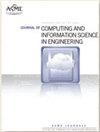增强现实中用于轨迹跟踪的辅助感觉反馈
IF 3.3
3区 工程技术
Q2 COMPUTER SCIENCE, INTERDISCIPLINARY APPLICATIONS
Journal of Computing and Information Science in Engineering
Pub Date : 2023-05-16
DOI:10.1115/1.4062543
引用次数: 0
摘要
近年来,增强现实(AR)已成功应用于各个领域,以帮助执行手动任务。然而,通过AR生成实时交互函数并有效提高任务效率的界面设计仍然缺乏一套完整的标准。本研究中,受试者在AR中执行了两种轨迹跟踪任务,即简单轨迹和复杂轨迹。比较了他们在中心视觉、周边视觉、听觉、触觉和无反馈五种不同感觉反馈下的任务表现。结果表明,在复杂轨迹中的轨迹跟踪任务中,反馈信息不仅要提供错误状态的提示,还要为被试纠正行为提供建议。此外,与视觉和听觉相比,触觉的反馈信息具有更好的适应性。此外,受试者倾向于依靠触觉的实时反馈来完成困难的任务。研究发现,在手动轨迹跟踪任务中,确定轨迹跟踪任务是否在可接受的轨迹范围内会受到受试者用于任务的姿势的影响,并会改变任务性能。因此,建议在设计辅助功能时,应考虑任务姿势的限制。本研究的实验结果和发现可为AR中手动任务的辅助界面设计提供参考。本文章由计算机程序翻译,如有差异,请以英文原文为准。
Assistive Sensory Feedback for Trajectory Tracking in Augmented Reality
In recent years, Augmented Reality (AR) has been successfully applied in various fields to assist in the execution of manual tasks. However, there is still a lack of complete set of criteria for interface design for generating real-time interactive functions and effectively improving the task efficiency through AR. In this study, subjects performed two kinds of trajectory tracking tasks in AR, the simple trajectory and complex trajectory. Their task performance under five different sensory feedbacks, namely, central vision, peripheral vision, auditory sensation, tactile sensation and no feedback, were compared. The results show that in the trajectory tracking task in complex trajectories, the feedback information should not only provide prompts of error states, but also provide suggestions for correcting the actions to the subjects. In addition, compared with visual sensation and auditory sensation, the feedback information of tactile sensation has better adaptation. Furthermore, the subjects tend to rely on the real-time feedback of tactile sensation to complete difficult tasks. It was found that in the manual trajectory tracking task, determining whether the trajectory tracking task is within the acceptable trajectory range will be affected by the postures subjects use for the tasks, and will change the task performance. Therefore, it is suggested that when designing auxiliary functions, the limitations of the postures of the task should be considered. The experimental results and findings obtained in this study can provide a reference for the auxiliary interface design of manual tasks in AR.
求助全文
通过发布文献求助,成功后即可免费获取论文全文。
去求助
来源期刊
CiteScore
6.30
自引率
12.90%
发文量
100
审稿时长
6 months
期刊介绍:
The ASME Journal of Computing and Information Science in Engineering (JCISE) publishes articles related to Algorithms, Computational Methods, Computing Infrastructure, Computer-Interpretable Representations, Human-Computer Interfaces, Information Science, and/or System Architectures that aim to improve some aspect of product and system lifecycle (e.g., design, manufacturing, operation, maintenance, disposal, recycling etc.). Applications considered in JCISE manuscripts should be relevant to the mechanical engineering discipline. Papers can be focused on fundamental research leading to new methods, or adaptation of existing methods for new applications.
Scope: Advanced Computing Infrastructure; Artificial Intelligence; Big Data and Analytics; Collaborative Design; Computer Aided Design; Computer Aided Engineering; Computer Aided Manufacturing; Computational Foundations for Additive Manufacturing; Computational Foundations for Engineering Optimization; Computational Geometry; Computational Metrology; Computational Synthesis; Conceptual Design; Cybermanufacturing; Cyber Physical Security for Factories; Cyber Physical System Design and Operation; Data-Driven Engineering Applications; Engineering Informatics; Geometric Reasoning; GPU Computing for Design and Manufacturing; Human Computer Interfaces/Interactions; Industrial Internet of Things; Knowledge Engineering; Information Management; Inverse Methods for Engineering Applications; Machine Learning for Engineering Applications; Manufacturing Planning; Manufacturing Automation; Model-based Systems Engineering; Multiphysics Modeling and Simulation; Multiscale Modeling and Simulation; Multidisciplinary Optimization; Physics-Based Simulations; Process Modeling for Engineering Applications; Qualification, Verification and Validation of Computational Models; Symbolic Computing for Engineering Applications; Tolerance Modeling; Topology and Shape Optimization; Virtual and Augmented Reality Environments; Virtual Prototyping

 求助内容:
求助内容: 应助结果提醒方式:
应助结果提醒方式:


